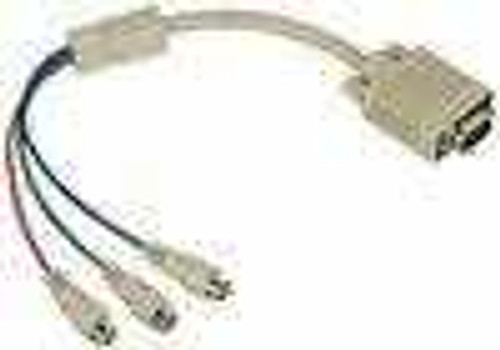Composite Video / S-Video to VGA Up-Converter Features:
- Composite Video Input via RCA connector
- S-Video Input val 4-Pin Mini-DIN connector
- Scaled output resolutions:
- PC resolutions: XGA, SXGA, UXGA
- Component resolutions: 480p/576p, 720p, 1080p
- SVGA /XGA / SXGA Output direct to PC monitor
- Component video (Y-Pb-Pr) output via an optional VGA to component cable seen above
- Motion Adaptive Y/C Separation of Composite Video (3D Comb Filtering).
- Motion Adaptive 3D YNR / CNR Noise Reduction for Y/C Video Input.
- Automatic 2:2 and 3:2 Film Mode Detection.
- No need to move wiring around
- NTSC and PAL Automatic Input Detection
The Composite & S-Video to VGA or Component Converter has both Composite Video and S-Video inputs that can be converted to SVGA, XGA or SXGA. It works with almost any video signal in either NTSC or PAL standards, such as from a VCR, DVD or Video Game. The output resolution is switch selectable.
Advanced features include Motion Adaptive Y/C Separation of Composite Video (3D Comb Filtering), Motion Adaptive 3D YNR / CNR Noise Reduction for Y/C Video Input and Automatic 2:2 and 3:2 Film Mode Detection. There are many factors affecting the quality of results when scaling video signals. Some basic precautions will ensure the best possible performance from your Composite Video / S-Video to VGA Up-Converter.
Why not buy this Composite & S-Video to VGA or Component Converter today
Composite & S-Video to VGA or Component Converter Specs:
- Operates in NTSC 3.58MHz and PAL system
- Can scale CV/SV to PC or Component format
- Output resolution:
- PC resolutions: XGA, SXGA, UXGA
- Component resolutions: 480p/576p, 720p, 1080p
- 3D (frame based) motion adaptive YNR/CNR noise reduction
- On-Screen Display
- Advance 3D motion adaptive de-interlacing
- Automatic 2:2 & 3:2 film mode detection
- 50/60 Hz frame rate conversion ensures glitch-free display
- Play video games on your VGA monitors
- High-resolution output picture
- Plug & play - no software required
- H-W-D: 0.9"x3.9"x2.5" (24x100x64mm)
- Weight: 7 oz (200g)
- 3.3VDC Powered
- 100~240VAC to 3.3VDC Power Adapter supplied
This Composite & S-Video to VGA or Component Converter can be used with:
- Dish Network and DirecTV receivers with S-Video or composite video outputs
- TiVo's with S-Video or composite video outputs
- Cable receivers with S-Video or composite video outputs
- Sony PS2 with S-Video or composite video outputs
- Xbox with S-Video or composite video outputs
- DVD players with S-Video or composite video outputs
- A/V surround sound receivers / preamps with S-Video or composite video switching
- Surveillance cameras with S-Video or composite video outputs
- and other similar devices with S-Video or composite video outputs.
A:
- Output display device: The quality of the output signal will depend largely upon the type and quality of display device used. For instance, some video projectors just look better than others.
- Distance between the Up Converter and the display device: This plays a major role in the final result. Long distances are possible, but special measures should be taken in order to avoid cable losses. These include using high quality cables. Line amplifiers may also be necessary.
- Input/Output connection cables: Low quality cables are susceptible to interference. They degrade signal quality due to poor matching and cause elevated noise levels. Therefore, cables should be of the best quality. Coax-type computer cables are recommended because of their superior internal shielding characteristics.
- Interference from nearby electrical devices: These can have an adverse effect on signal quality. For example, an older computer monitor often emits very high electromagnetic fields that can interfere with the performance of video equipment in its proximity.









